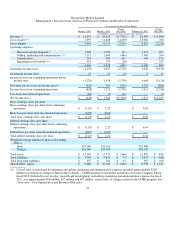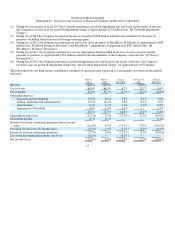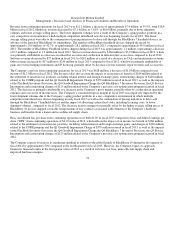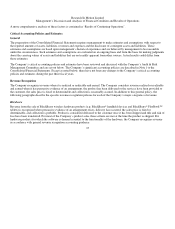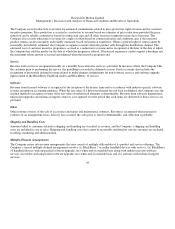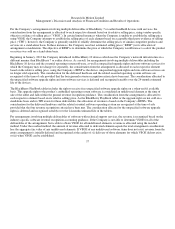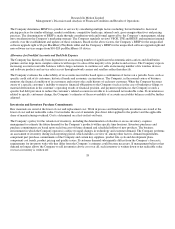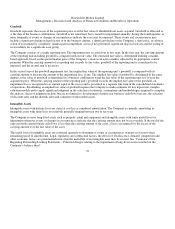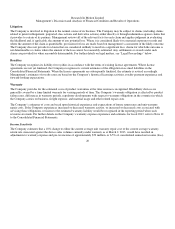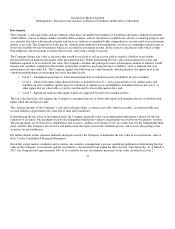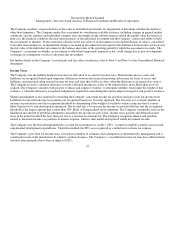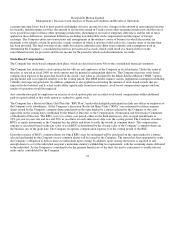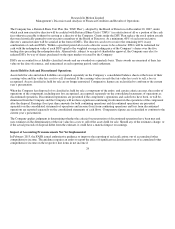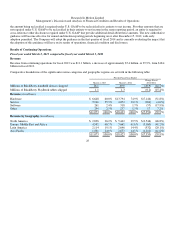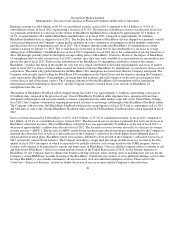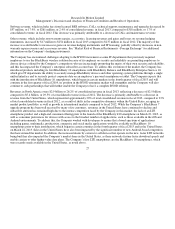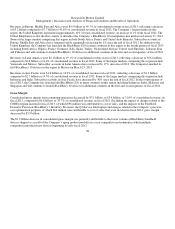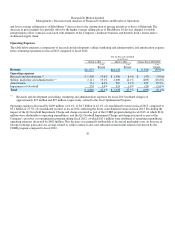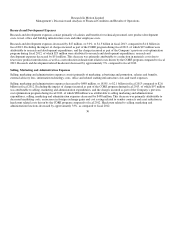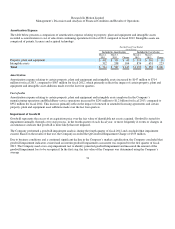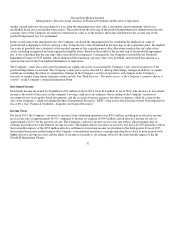Blackberry 2013 Annual Report Download - page 187
Download and view the complete annual report
Please find page 187 of the 2013 Blackberry annual report below. You can navigate through the pages in the report by either clicking on the pages listed below, or by using the keyword search tool below to find specific information within the annual report.
Research In Motion Limited
Management’s Discussion and Analysis of Financial Condition and Results of Operations
The Company regularly assesses declines in the value of individual investments for impairment to determine whether the decline is
other-than-temporary. The Company makes this assessment by considering available evidence, including changes in general market
conditions, specific industry and individual company data, the length of time and the extent to which the market value has been less
than cost, the financial condition, the near-term prospects of the individual investment and the Company’s intent and ability to hold
the investments to maturity. In the event that a decline in the fair value of an investment occurs and the decline in value is considered
to be other-than-temporary, an impairment charge is recorded in investment income equal to the difference between the cost basis and
the fair value of the individual investment at the balance sheet date of the reporting period for which the assessment was made. The
Company’s assessment on whether an investment is other-than-temporarily impaired or not, could change due to new developments
or changes in assumptions or risks to any particular investment.
For further details on the Company’s investments and fair value conclusions, refer to Note 4 and Note 5 to the Consolidated Financial
Statements.
Income Taxes
The Company uses the liability method of income tax allocation to account for income taxes. Deferred income tax assets and
liabilities are recognized based upon temporary differences between the financial reporting and income tax bases of assets and
liabilities, and measured using enacted income tax rates and laws that will be in effect when the differences are expected to reverse.
The Company records a valuation allowance to reduce deferred income tax assets to the amount that is more likely than not to be
realized. The Company considers both positive evidence and negative evidence, to determine whether, based upon the weight of that
evidence, a valuation allowance is required. Judgment is required in considering the relative impact of negative and positive evidence.
Significant judgment is also required in evaluating the Company’s uncertain income tax positions and provisions for income taxes.
Liabilities for uncertain income tax positions are recognized based on a two-step approach. The first step is to evaluate whether an
income tax position has met the recognition threshold by determining if the weight of available evidence indicates that it is more
likely than not to be sustained upon examination. The second step is to measure the income tax position that has met the recognition
threshold as the largest amount that is more than 50% likely of being realized upon settlement. The Company continually assesses the
likelihood and amount of potential adjustments and adjusts the income tax provisions, income taxes payable and deferred income
taxes in the period in which the facts that give rise to a revision become known. The Company recognizes interest and penalties
related to uncertain income tax positions as interest expense, which is then netted and reported within investment income.
The Company uses the flow-through method to account for investment tax credits (“ITCs”) earned on eligible scientific research and
experimental development expenditures. Under this method, the ITCs are recognized as a reduction to income tax expense.
The Company’s provision for income taxes is based on a number of estimates and assumptions as determined by management and is
calculated in each of the jurisdictions in which it conducts business. The Company’s consolidated income tax rates have differed from
statutory rates primarily due to the tax impact of ITCs,
22


